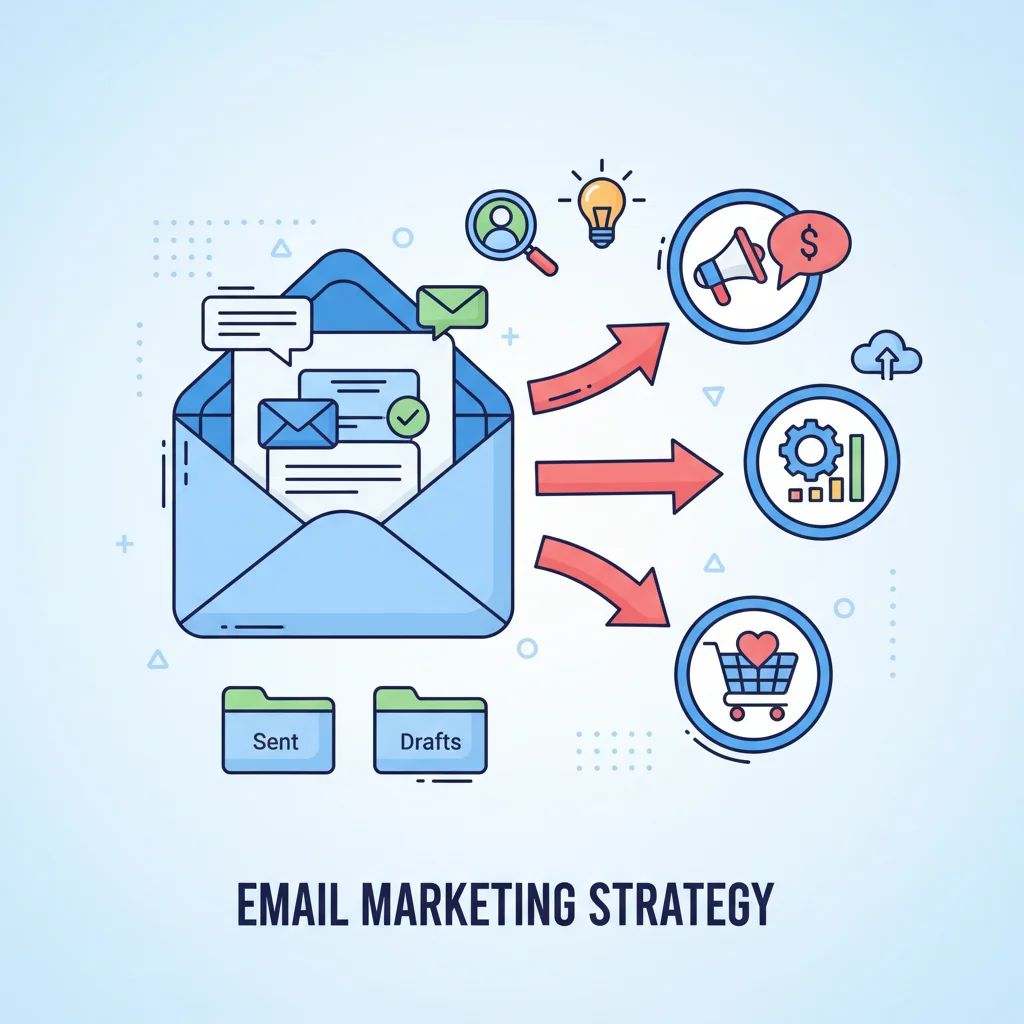Now Reading: Master Email Marketing Fundamentals: Building Customer Relationships That Convert
-
01
Master Email Marketing Fundamentals: Building Customer Relationships That Convert
Master Email Marketing Fundamentals: Building Customer Relationships That Convert

Among the various marketing channels available, email marketing fundamentals remain the cornerstone of successful digital marketing strategies. Despite the rise of social media and other communication platforms, email continues to deliver unparalleled results when implemented correctly.
Key Takeaways
- Email marketing is a digital strategy where businesses send targeted messages to subscribers who have opted in, with goals including promotion, relationship building, and driving conversions.
- The benefits for businesses include exceptional ROI ($40 for every $1 spent), personalized communication, direct customer access, and measurable results.
- Email marketing builds customer loyalty through regular, value-driven communication that keeps your brand top-of-mind.
- It’s highly cost-effective compared to traditional marketing methods, making it accessible for businesses of all sizes.
- Advanced segmentation and automation capabilities allow for targeted messaging that increases engagement and conversion rates.
What Is Email Marketing?
Email marketing is a powerful digital marketing strategy that involves sending targeted messages directly to a group of subscribers who have willingly opted in to receive communications from your business. These messages can take various forms, including promotional offers, newsletters, product updates, event invitations, or transactional confirmations. The primary objectives of email marketing are to promote products or services, nurture customer relationships, drive engagement, and foster customer loyalty and repeat business.
Unlike the mass “email blasts” that characterized early email marketing efforts, modern approaches emphasize consent, segmentation, and personalization. This ensures that content is relevant to each recipient based on their specific interests, behaviors, or position in the customer journey. This evolution has transformed email marketing from a simple broadcasting tool into a sophisticated, conversion-focused strategy.
Useful Articles:
Why Email Marketing Benefits Businesses
The continued dominance of email marketing in the digital landscape isn’t accidental. It offers numerous advantages that make it an indispensable tool for businesses of all sizes. Let’s explore the key benefits that make email marketing fundamentals so crucial for business success.
Exceptional Return On Investment
One of the most compelling reasons to invest in email marketing is its remarkable return on investment. With an average ROI of $40 for every dollar spent, email marketing outperforms other digital marketing channels like SEO ($22) and keyword ads ($17). This exceptional return makes email marketing one of the most cost-effective strategies available to businesses.
The high ROI stems from several factors:
- Low implementation costs: Email marketing requires minimal resources compared to traditional advertising channels.
- Direct access to interested consumers: Your messages reach people who have already expressed interest in your brand.
- Personalization capabilities: Targeted messaging increases relevance and conversion rates.
- Scalability: Email campaigns can be scaled up or down without proportional cost increases.
For example, Vancouver-based home decor brand Eternity Modern implemented a comprehensive email marketing strategy that generated $80,000 in additional revenue within just three months. Within 11 months, that figure had grown to an impressive $289,000, demonstrating the substantial impact email marketing can have on a business’s bottom line.
Building Customer Relationships And Loyalty
Email marketing provides an unparalleled opportunity to nurture relationships with your audience. Regular, value-driven email communications help businesses stay top-of-mind, educate customers, and foster trust. This ongoing conversation transforms one-time buyers into loyal advocates who not only make repeat purchases but also recommend your brand to others.
Through strategic email campaigns, you can:
- Welcome new subscribers and set expectations
- Provide exclusive content and offers to make subscribers feel valued
- Share company news and updates to maintain connection
- Solicit feedback to demonstrate that you value customer opinions
- Celebrate customer milestones to strengthen emotional bonds
These relationship-building efforts pay dividends in the form of increased customer lifetime value and reduced acquisition costs. By focusing on nurturing existing relationships rather than constantly chasing new customers, businesses can create a sustainable growth model.
Highly Targeted Marketing Through Segmentation
One of email marketing’s greatest strengths is its ability to deliver personalized messages to specific audience segments. Unlike broad-reach advertising channels, email allows you to tailor your communications based on demographics, purchase history, engagement level, and numerous other factors.
Effective segmentation strategies include:
- Demographic segmentation: Targeting based on age, location, gender, or occupation
- Behavioral segmentation: Customizing messages based on past purchases, website activity, or email engagement
- Lifecycle segmentation: Delivering content appropriate to the customer’s stage in the buying journey
- Preference-based segmentation: Sending content aligned with stated interests or preferences
This targeted approach ensures that recipients receive relevant content, significantly increasing the likelihood of engagement and conversion. For instance, segmented email campaigns have been shown to increase revenue by up to 760% compared to one-size-fits-all campaigns.
Cost-Effectiveness And Accessibility
Email marketing offers remarkable cost efficiency compared to traditional marketing channels like print, television, or direct mail. The primary expenses involve email marketing platform subscriptions and content creation, making it accessible to businesses with limited marketing budgets.
This cost-effectiveness stems from:
- No printing or postage costs: Digital delivery eliminates physical production expenses
- Reusable templates: Once created, email templates can be used repeatedly with minor modifications
- Automation capabilities: Reducing manual labor through automated workflows
- Precise targeting: Minimizing wasted impressions by reaching only interested parties
For small businesses and startups with constrained resources, email marketing provides an affordable way to reach customers and drive growth. Even with a modest investment, companies can implement sophisticated campaigns that deliver substantial returns.
Measurable Results And Data-Driven Optimization
Unlike many traditional marketing channels, email marketing provides comprehensive, real-time analytics that allow businesses to measure performance and optimize campaigns. This data-driven approach enables continuous improvement and ensures marketing efforts align with business objectives.
Key metrics to track include:
- Open rates: The percentage of recipients who open your emails
- Click-through rates: How many recipients click on links within your emails
- Conversion rates: The percentage of recipients who complete desired actions
- List growth rate: How quickly your subscriber list is growing
- Bounce rates: The percentage of emails that aren’t successfully delivered
- Unsubscribe rates: How many recipients opt out of future communications
By analyzing these metrics, marketers can identify what’s working and what isn’t, then make data-backed adjustments to improve performance. This iterative optimization process leads to increasingly effective campaigns over time.
Ownership And Control Of Communication Channel
Unlike social media platforms where algorithms determine content visibility, email marketing gives businesses direct access to their audience’s inboxes. This ownership provides greater control over messaging and distribution, ensuring your communications reach intended recipients.
The benefits of this ownership include:
- Independence from third-party platforms: No need to worry about algorithm changes affecting reach
- Direct relationship with subscribers: No intermediary controlling access to your audience
- Portable subscriber lists: Your email list remains an asset even if you change service providers
- Control over timing and frequency: You determine when and how often to communicate
This control is increasingly valuable as social media platforms continue to limit organic reach and charge for audience access. Your email list represents a owned marketing asset that provides reliable audience access regardless of changes in other channels.
Essential Email Marketing Fundamentals For Success
Now that we understand the benefits of email marketing, let’s explore the fundamental principles and strategies that drive successful campaigns. Mastering these email marketing fundamentals will help you maximize results and avoid common pitfalls.
Building A Quality Subscriber List
The foundation of effective email marketing is a high-quality subscriber list composed of people who have actively chosen to receive your communications. Building such a list takes time and strategic effort, but the results are worth the investment.
Best practices for list building include:
- Creating valuable lead magnets: Offer compelling resources like guides, templates, or tools in exchange for email addresses
- Implementing optimized signup forms: Place user-friendly forms at strategic locations throughout your website
- Using double opt-in processes: Confirm subscription interest to ensure list quality
- Leveraging social media: Promote email signup across your social channels
- Hosting webinars or events: Collect emails through registration processes
Remember that list quality matters more than quantity. A smaller list of engaged subscribers will outperform a large list of uninterested contacts. Focus on attracting people who genuinely want to hear from you and providing consistent value to maintain their interest.
Crafting Compelling Email Content
Even with a quality subscriber list, your email marketing efforts will fall flat without engaging, valuable content. Effective email content balances promotional messages with informative, entertaining, or educational material that subscribers find genuinely useful.
Elements of compelling email content include:
- Attention-grabbing subject lines: Create curiosity or communicate clear value to increase open rates
- Personalized greetings and content: Address subscribers by name and tailor content to their interests
- Clear, concise messaging: Respect readers’ time with straightforward communication
- Strong calls-to-action: Guide recipients toward desired next steps with compelling CTAs
- Mobile-friendly design: Ensure your emails display properly on all devices
- Visual elements: Incorporate relevant images, GIFs, or videos to enhance engagement
The most effective email content provides clear value to recipients, whether through exclusive offers, helpful information, entertainment, or inspiration. Always ask yourself what benefit the subscriber will gain from opening and reading your email.
Implementing Effective Segmentation Strategies
While we’ve touched on segmentation earlier, its importance warrants deeper exploration. Effective segmentation is the key to delivering relevant content that resonates with different portions of your audience.
Advanced segmentation strategies include:
- Purchase history segmentation: Targeting based on past buying behavior
- Engagement-level segmentation: Sending different content to highly engaged versus less active subscribers
- Geographic segmentation: Customizing messages based on location-specific factors
- Customer value segmentation: Providing special treatment to high-value customers
- Interest-based segmentation: Delivering content aligned with demonstrated interests
Implementing these segmentation strategies requires robust data collection and management, but the improved results justify the effort. Modern email marketing platforms offer sophisticated segmentation tools that make this process increasingly accessible.
Leveraging Automation For Efficiency And Timing
Email automation allows businesses to send timely, relevant messages triggered by specific actions or timeframes. This capability enables sophisticated customer journeys without requiring manual intervention for each message.
Key automation opportunities include:
- Welcome sequences: Introducing new subscribers to your brand and offerings
- Abandoned cart reminders: Recovering potential lost sales
- Post-purchase follow-ups: Enhancing the customer experience and encouraging reviews
- Re-engagement campaigns: Winning back inactive subscribers
- Birthday or anniversary emails: Celebrating customer milestones with special offers
Automation not only saves time but also ensures consistent communication at optimal moments in the customer journey. For example, abandoned cart emails sent within an hour of cart abandonment have significantly higher conversion rates than those sent later.
Optimizing For Mobile Users
With over 60% of email opens occurring on mobile devices, mobile optimization is no longer optional—it’s essential. Mobile-friendly emails ensure that your messages are accessible and effective regardless of the device used to view them.
Mobile optimization best practices include:
- Responsive design: Creating layouts that automatically adjust to different screen sizes
- Concise subject lines: Keeping them under 30 characters for mobile visibility
- Larger font sizes: Using at least 14pt for body text and 22pt for headlines
- Single-column layouts: Simplifying design for smaller screens
- Thumb-friendly buttons: Making CTAs large enough (at least 44×44 pixels) for easy tapping
- Reduced image sizes: Optimizing for faster loading on mobile networks
Testing your emails across multiple devices and email clients ensures consistent performance regardless of how subscribers access your messages.
Testing And Optimization Techniques
Continuous testing and optimization are crucial for maximizing email marketing performance. A/B testing (comparing two versions of an email to see which performs better) provides data-driven insights that inform future campaign decisions.
Elements worth testing include:
- Subject lines: Testing different approaches to improve open rates
- Send times: Identifying optimal delivery times for your specific audience
- Email design: Comparing different layouts, colors, or image placements
- Call-to-action buttons: Testing variations in text, color, size, or placement
- Content length: Determining whether your audience prefers concise or detailed messages
- Personalization elements: Measuring the impact of different personalization strategies
Each test provides valuable information about subscriber preferences, allowing you to refine your approach over time. Even small improvements can compound to deliver significant results when applied consistently.
Useful Articles:
Advanced Email Marketing Strategies
Once you’ve mastered the fundamentals, consider implementing these advanced strategies to further enhance your email marketing effectiveness.
Integrating Email With Other Marketing Channels
While email marketing is powerful on its own, its effectiveness multiplies when integrated with other marketing channels. A cohesive cross-channel approach creates a seamless customer experience and reinforces your messaging across multiple touchpoints.
Effective integration strategies include:
- Coordinating email and social media campaigns: Using consistent messaging and visuals across platforms
- Combining email with retargeting ads: Reinforcing email messages with targeted display advertising
- Integrating email and content marketing: Promoting your best content through email and vice versa
- Connecting email and in-person events: Using email for event promotion and follow-up
- Aligning email with SEO efforts: Using email to promote high-value content that supports SEO goals
For example, email marketing and SEO can work together synergistically. Your email campaigns can reveal which topics generate the most engagement, guiding your content creation strategy for SEO. Similarly, when users click through from emails to your website content, it sends positive engagement signals to search engines.
Leveraging Artificial Intelligence And Predictive Analytics
Artificial intelligence and predictive analytics are revolutionizing email marketing by enabling more sophisticated personalization, timing, and content strategies.
Advanced AI applications in email marketing include:
- Predictive send-time optimization: Determining the optimal delivery time for each individual subscriber
- Content recommendations: Suggesting products or content based on past behavior and preferences
- Dynamic content generation: Automatically creating personalized content for different segments
- Churn prediction: Identifying subscribers at risk of disengagement before they leave
- Subject line optimization: Generating and testing effective subject lines
These technologies allow marketers to deliver increasingly personalized experiences at scale, improving engagement and conversion rates while reducing manual workload.
Implementing Interactive Email Elements
Interactive emails incorporate elements that recipients can engage with directly within the email itself, without needing to visit a website. These interactive features increase engagement and provide a more immersive experience.
Popular interactive elements include:
- Polls and surveys: Gathering feedback directly within emails
- Image carousels: Showcasing multiple products or images in a limited space
- Accordion menus: Expanding sections to reveal additional content
- Add-to-cart functionality: Enabling purchases without leaving the email
- Interactive calculators: Providing personalized results based on user input
While these advanced elements require more sophisticated development, they can significantly boost engagement and conversion rates for businesses ready to push the boundaries of traditional email marketing.
Measuring Email Marketing Success
To truly understand the impact of your email marketing efforts, you need to establish clear metrics and measurement processes. This data-driven approach ensures you can demonstrate ROI and continuously improve your strategies.
Key Performance Indicators To Track
While we touched on metrics earlier, let’s explore the most important KPIs in greater depth:
- Open rate: The percentage of recipients who open your email, indicating subject line effectiveness and sender reputation
- Click-through rate (CTR): The percentage of recipients who click on at least one link, measuring content relevance and engagement
- Conversion rate: The percentage of recipients who complete a desired action after clicking, reflecting overall campaign effectiveness
- Revenue per email: The average revenue generated by each email sent, directly tying campaigns to financial results
- List growth rate: The rate at which your email list is growing (or shrinking), indicating acquisition effectiveness
- Bounce rate: The percentage of emails that weren’t delivered, highlighting list quality issues
- Unsubscribe rate: The percentage of recipients who opt out after receiving an email, signaling content relevance problems
These metrics should be tracked consistently over time to identify trends and measure improvement. Most email marketing platforms provide built-in analytics dashboards that make this tracking relatively straightforward.
Attribution Models For Email Marketing
Attribution modeling helps determine how much credit email marketing should receive for conversions, especially when customers interact with multiple marketing channels before purchasing.
Common attribution models include:
- Last-click attribution: Giving full credit to the last channel the customer interacted with before converting
- First-click attribution: Assigning full credit to the first touchpoint in the customer journey
- Linear attribution: Distributing credit equally across all touchpoints
- Time-decay attribution: Giving more credit to touchpoints closer to the conversion
- Position-based attribution: Assigning more credit to the first and last touchpoints
The right attribution model depends on your business model and customer journey. Many sophisticated marketers use multi-touch attribution to gain a more nuanced understanding of how email marketing contributes to overall results.
Useful Articles:
Overcoming Common Email Marketing Challenges
Even with a solid understanding of email marketing fundamentals, businesses often encounter challenges that can hinder their success. Let’s explore some common obstacles and strategies for overcoming them.
Deliverability Issues And Solutions
Email deliverability—the ability to reach subscribers’ inboxes rather than spam folders—is a critical concern for email marketers. Poor deliverability can undermine even the most brilliant campaign strategy.
To improve deliverability:
- Maintain list hygiene: Regularly remove inactive subscribers and invalid email addresses
- Implement authentication protocols: Use SPF, DKIM, and DMARC to verify your identity
- Monitor engagement metrics: Low open rates can trigger spam filters
- Avoid spam trigger words: Be cautious with terms like “free,” “guarantee,” or excessive punctuation
- Provide easy unsubscribe options: Making it simple to opt out reduces spam complaints
- Warm up new IP addresses: Gradually increase sending volume when using a new IP
Regular deliverability audits can help identify and address issues before they significantly impact your campaigns.
Compliance With Email Regulations
Email marketing is subject to various regulations worldwide, including the CAN-SPAM Act, GDPR, and CCPA. Non-compliance can result in significant penalties and damage to your brand reputation.
Key compliance considerations include:
- Obtaining proper consent: Ensuring subscribers have explicitly opted in to receive your communications
- Providing clear unsubscribe mechanisms: Making it easy for recipients to opt out
- Including your physical address: Adding your business location in every email
- Honest subject lines: Avoiding deceptive or misleading subject lines
- Identifying promotional content: Clearly labeling advertisements as such
- Honoring privacy requests: Respecting data access and deletion requests
Working with legal experts to ensure compliance with relevant regulations in all jurisdictions where you have subscribers is a worthwhile investment.
Combating Email Fatigue And List Churn
Subscriber fatigue and list churn (the rate at which people unsubscribe) can undermine your email marketing efforts over time. Maintaining subscriber interest requires strategic planning and content variety.
To reduce fatigue and churn:
- Optimize sending frequency: Find the right balance between staying top-of-mind and overwhelming subscribers
- Provide consistent value: Ensure each email offers something worthwhile to recipients
- Implement preference centers: Allow subscribers to choose content types and frequency
- Re-engagement campaigns: Attempt to win back inactive subscribers before removing them
- Content variety: Mix promotional emails with educational, entertaining, or inspiring content
- Segment based on engagement: Send fewer emails to less engaged subscribers
Remember that some list churn is natural and even healthy—it’s better to have a smaller list of engaged subscribers than a large list of uninterested ones.
Email Marketing Fundamentals: Tools And Resources
Implementing effective email marketing strategies requires the right tools and resources. Let’s explore the options available to businesses at different stages of growth.
Email Marketing Platforms Comparison
Numerous email marketing platforms offer varying features, pricing structures, and specializations. Choosing the right platform depends on your specific needs, technical capabilities, and budget.
Popular email marketing platforms include:
- Mailchimp: User-friendly with strong analytics and a generous free tier for small businesses
- Constant Contact: Intuitive interface with excellent customer support
- HubSpot: Comprehensive marketing automation with CRM integration
- Klaviyo: E-commerce focused with powerful segmentation capabilities
- ActiveCampaign: Advanced automation features at competitive prices
- ConvertKit: Creator-focused with simple but powerful automation tools
When evaluating platforms, consider factors like ease of use, automation capabilities, integration options, analytics features, deliverability rates, and scalability as your business grows.
Essential Resources For Email Marketers
Beyond technology platforms, email marketers benefit from various resources that help improve their skills and stay current with industry trends.
Valuable resources include:
- Industry blogs: Publications like Email on Acid, Litmus, and Really Good Emails
- Email marketing communities: Forums and social media groups where marketers share insights
- Testing tools: Services that check rendering across email clients and devices
- Template libraries: Collections of proven email designs to adapt for your campaigns
- Copywriting resources: Guides for writing effective subject lines and email content
- Regulatory guidance: Resources explaining compliance requirements in different regions
Continuous learning is essential in the rapidly evolving email marketing landscape. Allocating time for professional development ensures your strategies remain current and effective.
Email marketing fundamentals remain the backbone of effective digital marketing strategies for businesses of all sizes. With its unparalleled ROI, direct customer access, and sophisticated targeting capabilities, email marketing continues to outperform other channels in driving engagement, building relationships, and generating revenue.




















